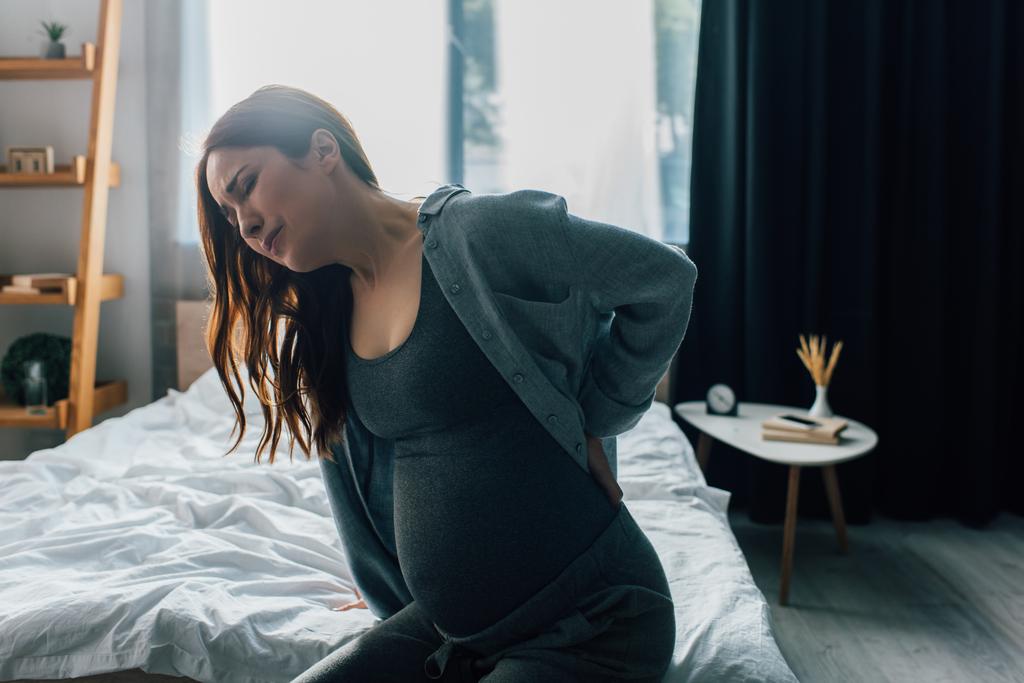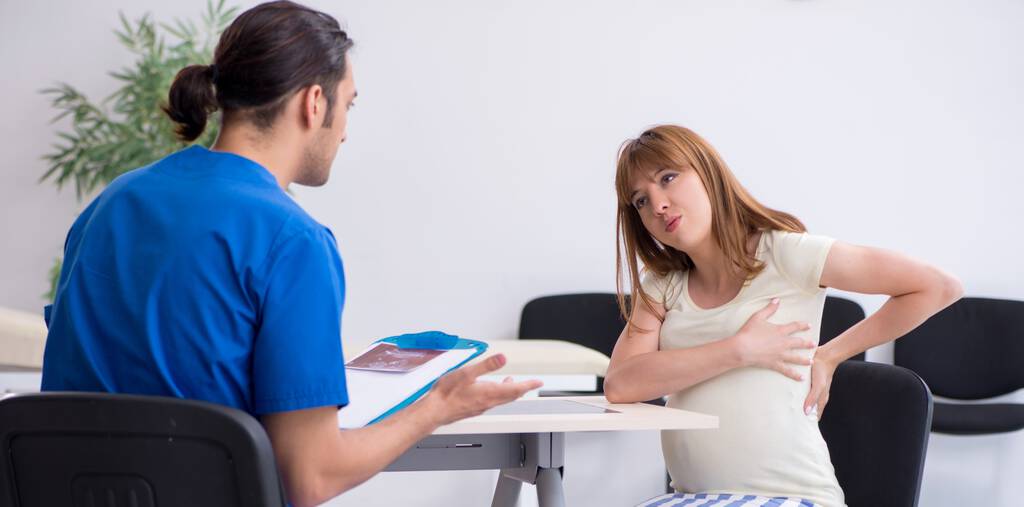Discover the reasons behind back pain during pregnancy and gain a deeper understanding of why some women experience this discomfort.
Understanding Why Some Women Experience Back Pain During Pregnancy
Being pregnant is an exciting and beautiful experience, but it can also come with its fair share of discomforts. One of the most common complaints among expectant mothers is back pain. If you’re wondering why some women experience this ache during pregnancy, you’ve come to the right place. In this article, we’ll delve into the anatomy of pregnancy-related back pain, explore different types of back pain that can occur, and discuss preventive measures and medical interventions to manage the discomfort.

The Anatomy of Pregnancy-Related Back Pain
Pregnancy is a time of tremendous changes in a woman’s body, both externally and internally. These changes can put strain on various parts of the body, including the back. Hormones, weight gain, and postural changes all play a significant role in causing back pain during pregnancy.
Let’s delve deeper into the fascinating world of pregnancy-related back pain and explore the intricate mechanisms behind it.
The Role of Hormones in Pregnancy Back Pain
During pregnancy, your body produces hormones, such as relaxin, which loosen the ligaments and joints in preparation for childbirth. While this is necessary for the birthing process, it can also affect the stability of your spine, leading to discomfort.
Relaxin, as its name suggests, relaxes the ligaments and joints in your body, allowing them to stretch and accommodate the growing fetus. However, this hormonal relaxation can cause the ligaments supporting your spine to become more lax, leading to instability and potential pain. The loosening of these ligaments can also affect the alignment of your vertebrae, contributing to back pain.
Additionally, relaxin can impact the muscles in your back, causing them to become more relaxed and less able to support your spine effectively. This muscle weakness can further exacerbate pregnancy-related back pain.
It’s truly remarkable how these hormonal changes, essential for the miraculous process of childbirth, can also bring about temporary discomfort and challenges for expectant mothers.
The Impact of Weight Gain on the Spine
As your baby grows, so does your belly, and with it, your weight increases. This added weight puts extra pressure on your spine, leading to strain and potential pain.
During pregnancy, the weight gain is not limited to just the baby. Your body also undergoes changes in blood volume, fluid retention, and increased breast size. All of these factors contribute to an overall increase in body weight, which your spine has to bear.
The additional weight places a greater load on the intervertebral discs, which act as cushions between the vertebrae. Over time, this increased pressure can lead to compression of the discs and the surrounding nerves, resulting in back pain.
It’s important to note that weight gain during pregnancy is a natural and necessary part of the process. However, understanding the impact it can have on your spine allows you to take proactive measures to alleviate discomfort and support your back health.
Postural Changes and Their Effects
Throughout pregnancy, your center of gravity shifts forward, causing changes in your posture. This shift can result in added stress on your back and contribute to the development of back pain.
As your baby grows, your expanding uterus alters your body’s alignment. To compensate for the extra weight at the front, your body naturally adjusts its posture, often leading to a more pronounced arch in the lower back, known as lordosis. This change in posture can strain the muscles and ligaments in your back, leading to pain and discomfort.
Furthermore, as your belly grows, you may find yourself adopting different positions and movements to accommodate your changing body. These adaptations can inadvertently place additional stress on specific areas of your back, contributing to the development of pregnancy-related back pain.
Understanding the impact of postural changes during pregnancy can empower you to make conscious adjustments to your posture and seek appropriate support to alleviate strain on your back.
As you can see, pregnancy-related back pain is a complex and multifaceted phenomenon. The interplay between hormones, weight gain, and postural changes creates a unique set of challenges for expectant mothers. By gaining a deeper understanding of the anatomy behind pregnancy-related back pain, you can better navigate this transformative journey and find ways to support your back health throughout pregnancy.
Different Types of Back Pain in Pregnancy
Not all pregnancy-related back pain is the same. It can manifest in different ways, and understanding the different types can help you better manage and alleviate your discomfort.
During pregnancy, your body undergoes numerous changes to accommodate the growing baby. These changes can put strain on your back, leading to various types of back pain. Let’s explore some of the most common types:
Lumbar Pain During Pregnancy
Lumbar pain is the most common type of back pain experienced during pregnancy. It typically affects the lower back and can range from mild to severe. The weight of the growing uterus, hormonal changes, and changes in posture can contribute to lumbar pain. It may feel like a dull ache or a sharp, shooting pain.
To alleviate lumbar pain, it’s important to maintain proper posture. Avoid slouching and try to distribute your body weight evenly. Engaging in gentle exercises, such as prenatal yoga or swimming, can help strengthen the muscles in your back and provide relief. Additionally, using a pregnancy support pillow while sleeping can help alleviate the pressure on your lower back.
Posterior Pelvic Pain in Pregnant Women
Posterior pelvic pain is felt in the back of the pelvis, near the tailbone. This type of pain can be sharp and shooting, making it difficult to perform even simple tasks. The weight of the baby, hormonal changes, and the relaxation of ligaments in the pelvic area can contribute to posterior pelvic pain.
If you’re experiencing this type of pain, rest is crucial. Avoid activities that aggravate the pain and try to find comfortable positions that relieve the pressure on your pelvis. Pelvic exercises, such as Kegels, can help strengthen the muscles in the pelvic area and provide support. Some pregnant women find relief by using supportive belts or braces that help stabilize the pelvis.
Sciatica: A Common Pregnancy Complaint
Sciatica is a condition characterized by pain radiating from the lower back through the buttocks and down the leg. The pressure on the sciatic nerve during pregnancy can lead to the development of this painful condition. Hormonal changes and the growing uterus can contribute to the compression of the sciatic nerve.
To find relief from sciatica, stretching exercises can be beneficial. Gentle stretches that target the lower back and buttocks can help alleviate the pressure on the sciatic nerve. Applying hot or cold therapy to the affected area may also provide temporary relief. It’s important to consult with your healthcare provider before attempting any new exercises or therapies.
Remember, every pregnancy is unique, and the severity and duration of back pain can vary. If you’re experiencing persistent or severe back pain, it’s important to consult with your healthcare provider for a proper diagnosis and personalized treatment plan.
Prevention and Management of Pregnancy Back Pain
While back pain during pregnancy is common, there are steps you can take to prevent and alleviate it.
During pregnancy, the body goes through numerous changes to accommodate the growing baby. These changes can put strain on the back, leading to discomfort and pain. However, with the right strategies, you can minimize the impact of back pain and enjoy a more comfortable pregnancy.
Importance of Good Posture and Ergonomics
Maintaining good posture is crucial for preventing and alleviating back pain during pregnancy. When you sit or stand with proper alignment, you reduce the strain on your back muscles and ligaments. It is essential to be mindful of your posture throughout the day.
While sitting, make sure to sit up straight and avoid slouching. Place a cushion or pillow behind your lower back for added support. This will help maintain the natural curve of your spine and relieve pressure on the back.
When standing, distribute your weight evenly on both feet and avoid locking your knees. Imagine a string pulling you up from the top of your head, lengthening your spine. This will help you maintain a neutral spine position and reduce the risk of developing back pain.
In addition to good posture, using ergonomic support can provide extra comfort and further reduce the risk of developing back pain. Invest in a supportive chair with proper lumbar support. You can also use pillows or cushions to provide additional support to your back while sitting or lying down.
Safe Exercise Routines for Pregnant Women
Regular exercise during pregnancy can help strengthen the muscles that support your back and improve posture. It is important to choose exercises that are safe and suitable for pregnant women.
Low-impact activities like walking, swimming, and prenatal yoga are highly beneficial for both you and your baby. These exercises help improve flexibility, strengthen the core muscles, and promote overall well-being. They also increase blood flow, which can reduce inflammation and alleviate back pain.
Before starting any exercise routine, consult with your healthcare provider to ensure that it is safe for you and your baby. They can provide personalized recommendations based on your health and fitness level.
The Role of Prenatal Massage in Alleviating Back Pain
Prenatal massage is a safe and effective way to alleviate back pain during pregnancy. Not only does it offer relaxation, but it also targets tense muscles and improves blood circulation.
During a prenatal massage, a licensed massage therapist with experience in treating pregnant women will use techniques specifically designed to address the unique needs of expectant mothers. They will focus on areas of tension, such as the lower back, hips, and shoulders, using gentle and soothing strokes.
In addition to relieving back pain, prenatal massage can also help reduce stress and anxiety, improve sleep quality, and enhance overall well-being. It is important to choose a licensed massage therapist who specializes in prenatal massage to ensure the safety and comfort of both you and your baby.
Remember, it is always advisable to consult with your healthcare provider before starting any new treatments or therapies during pregnancy.
Medical Interventions for Severe Pregnancy Back Pain
For some women, pregnancy back pain can become severe and challenging to manage with lifestyle changes alone. In such cases, seeking medical intervention is essential.

When to Seek Medical Help
If your back pain is persistent, severe, or accompanied by other concerning symptoms, it’s crucial to reach out to your healthcare provider. They can evaluate your condition and determine the best course of action.
Medication and Pregnancy: What’s Safe?
Not all pain medications are safe during pregnancy. Some medications may have potential risks for you and your baby. Therefore, it’s crucial to consult your healthcare provider before taking any medication for back pain during pregnancy.
Exploring the Option of Physical Therapy
Physical therapy can be an effective treatment option for severe pregnancy-related back pain. A physical therapist can guide you through exercises and techniques that target the specific source of your pain while ensuring the safety of both you and your baby.
Remember, back pain during pregnancy is a common discomfort, but it doesn’t have to take away from the joy of your pregnancy journey. By understanding the causes and types of back pain, as well as implementing preventive measures and seeking appropriate medical care if needed, you can enjoy a more comfortable and pain-free pregnancy.



